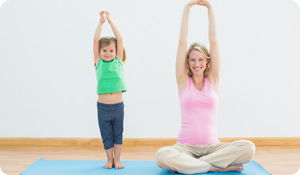
Once you've decided to take advantage of everything yoga can offer—including better physical fitness and reduced stress levels—you still have a big decision to make. With so many styles, studios, and classes out there, how do you know which one is for you? We’re here to make that decision a little bit easier.
"There's a lot to consider when you’re new to yoga and figuring out what’s right for you, like whether you want a structured practice where you know what poses you’ll do at each session or something more varied," offers Michelle Valentino, a certified yoga instructor at The Movement Center in Portland, Oregon. "Do you want a practice that’s fast paced or slow, athletic or leisurely? Do you want to focus on alignment and precision? Do you need to use props, or do you want to move freely and quickly from one pose to the next?"
You also have to ask yourself (and your doctor) if you’re healthy and fit enough for a particular yoga style. People with certain health conditions and absolute beginners might do well to steer clear of very demanding kinds of yoga.
Here are eight of the most popular and widely available styles of yoga. We recommend you start in a class with a certified teacher. Once you’ve learned the basics and how to accommodate your body’s needs, you can practice many of these styles on your own at home.
1. Hatha Yoga
The term "hatha" refers to any style of yoga that’s based on a series of exercises or postures, AKA asanas. Almost every style of yoga taught in the United States is Hatha. Whether it’s a fast paced and vigorous practice, like vinyasa or flow yoga, or gentle and relaxing like restorative yoga, it’s really all hatha. But if you’re looking at a class list offered by a yoga studio, hatha yoga probably means that it’s slow-paced and gradually leads from one asana to the next.
2. Kundalini Yoga
Kundalini yoga aligns specific breathing techniques with asanas and the chanting of mantras (specific Sanskrit sounds) to develop spiritual awareness. It is intended to release the flow of energy that travels through seven chakras (energy centers) in the body. It’s not a religious practice, but those who practice Kundalini describe it as deeply meditative and spiritual.
3. Vinyasa Yoga
Sometimes called flow or power yoga, vinyasa is a fast-paced, athletic practice that coordinates the breath with movement through a specific sequence of asanas. Some teachers choreograph their sequences to music. Vinyasa yoga moves quickly and is challenging, making it a great choice for those looking for a serious workout.
4. Ashtanga Yoga
Similar to vinyasa yoga, ashtanga combines breathing with flowing movements through a precise series of asanas. Ashtanga differs from vinyasa in its focus on "the eight limbs of yoga." Asanas are just one of those limbs—the others are morality, integrity and ethical guidelines, self-discipline and spiritual observance, breath work, sense withdrawal, concentration, and meditation.
5. Bikram Yoga
Sometimes called "hot yoga," this precise series of 26 postures is always practiced in a room heated to a steamy 104-105 degrees. The theory is that this temperature mimics the climate of India, where yoga originated, and allows the muscles and ligaments to be their most flexible. Bikram is controversial because many people can’t stand the heat and its founder, Bikram Choudhury, has made headlines for personal and legal troubles. However, those who practice Bikram swear by this challenging athletic practice and its impact on health and wellbeing.
6. Iyengar Yoga
One of the most widely practiced styles, Iyengar is named for B.K.S. Iyengar, who developed this style. Iyengar emphasizes precise body alignment during each asana. It uses props like blocks, belts, and blanket rolls to help the practitioner achieve their best pose, as well as accommodate any physical limitations. Iyengar yoga practitioners hold poses for longer periods of time, which, along with the emphasis on precision, helps build strength, stamina, balance, and flexibility. This is a great choice for anyone new to yoga and those with physical limitations.
7. Restorative Yoga
Based on practices developed in Iyengar yoga, restorative yoga helps the practitioner achieve deep relaxation. "It’s a great choice for people who have an overactive life, mental or emotional challenges, and those who just want a slower-paced class," Valentino says. Classes typically include a limited number of asanas held for as long as five minutes. Practitioners often use props to help hem hold poses while e completely relaxing and resting.
8. Yin Yoga
This slow-paced style is designed to prepare the body for meditation by focusing on poses that strengthen and stretch muscles, connective tissue, and ligaments. Poses are held for several minutes and practitioners are asked to relax deeply into each pose. "Yin is more vigorous than restorative yoga and allows people to experience what it’s like to hold poses for an extended period of time," Valentino explains.
Still not sure what's right for you? Try a few different classes and see what appeals. After all, "There’s something for everyone these days in the various styles of yoga," Valentino notes. "With a little experimentation and investigation, you’ll find something that fits your life and body."
Michelle Valentino reviewed this article.
Sources
Valentino, Michelle. The Movement Center. Phone interview March 31, 2016.
"Yoga 101." Yoga Journal. Accessed April 1, 2016.
"What Is Bikram Yoga?" Bikram Yoga. Accessed April 1, 2016.
"B.K.S Iyengar Home." B K S Iyengar Yoga: The Official Website. Accessed April 1, 2016.
"AYI.info—The International Ashtanga Yoga Information Page." AYI. Accessed April 1, 2016.





